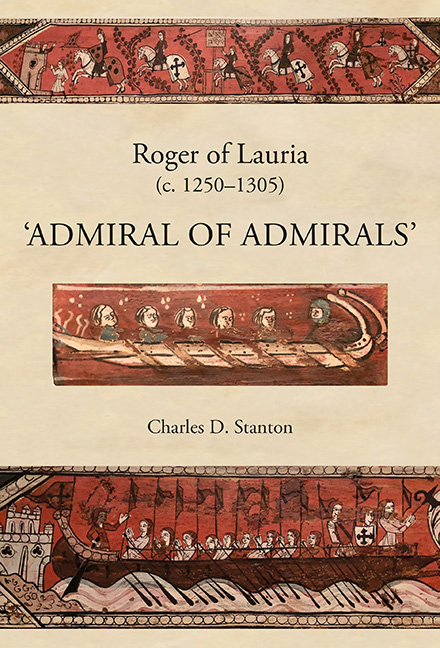Book contents
- Frontmatter
- Dedication
- Contents
- List of Illustrations
- Prologue
- 1 Battle of Benevento (26 February 1266)
- 2 A Calabrian Exile in the Court of Aragon (1262–1282)
- 3 Battle of Tagliacozzo (23 August 1268)
- 4 Aragonese Expansion (1229–1282)
- 5 Angevin Consolidation and Aggrandizement (1268–1282)
- 6 Revolt of the Vespers (30 March 1282)
- 7 Aragonese Intervention (August–October 1282)
- 8 Stalemate (November 1282–March 1283)
- 9 Admiral of Aragon (20 April 1283)
- 10 The Opposing Fleets (1282–1302)
- 11 Battle of Malta (8 June 1283)
- 12 Anjou's Dreams of Empire Dashed (June–November 1284)
- 13 France's Crusade Against Aragon (May–November 1285)
- 14 Battle of the Counts (23 June 1287)
- 15 Truces and Treaties (June 1287–November 1291)
- 16 Raid on Romania (Summer 1292)
- 17 Switching Sides (December 1293–April 1297)
- 18 Aragon's Invasion of Sicily at Anjou's Bidding (1298/1299)
- 19 Lauria's Last Great Campaign (Summer 1299–Spring 1300)
- 20 Endgame (Spring 1301–Summer 1302)
- Epilogue
- Bibliography
- Index
- Frontmatter
- Dedication
- Contents
- List of Illustrations
- Prologue
- 1 Battle of Benevento (26 February 1266)
- 2 A Calabrian Exile in the Court of Aragon (1262–1282)
- 3 Battle of Tagliacozzo (23 August 1268)
- 4 Aragonese Expansion (1229–1282)
- 5 Angevin Consolidation and Aggrandizement (1268–1282)
- 6 Revolt of the Vespers (30 March 1282)
- 7 Aragonese Intervention (August–October 1282)
- 8 Stalemate (November 1282–March 1283)
- 9 Admiral of Aragon (20 April 1283)
- 10 The Opposing Fleets (1282–1302)
- 11 Battle of Malta (8 June 1283)
- 12 Anjou's Dreams of Empire Dashed (June–November 1284)
- 13 France's Crusade Against Aragon (May–November 1285)
- 14 Battle of the Counts (23 June 1287)
- 15 Truces and Treaties (June 1287–November 1291)
- 16 Raid on Romania (Summer 1292)
- 17 Switching Sides (December 1293–April 1297)
- 18 Aragon's Invasion of Sicily at Anjou's Bidding (1298/1299)
- 19 Lauria's Last Great Campaign (Summer 1299–Spring 1300)
- 20 Endgame (Spring 1301–Summer 1302)
- Epilogue
- Bibliography
- Index
Summary
THE WAR OF THE SICILIAN VESPERS subtly shifted westward the fulcrum of power in the medieval Mediterranean, and the Catalan fleet under Roger of Lauria served as a strong catalyst for that realignment. The moribund Eastern Empire was gradually receding under Ottoman pressure, and the Latin Kingdom of Jerusalem existed in exile only, after the fall of Acre to the Mamluks in 1291. As a result, such traditional maritime powers as Venice and Genoa lost some of their reach and dominance. Catalonian commerce, attended by its newfound naval capability, began to fill the void. By seizing Sicily and the adjacent islands in the course of the war, the Catalans of the Crown of Aragon were able to establish control of the central Mediterranean in much the same way the Normans had under King Roger II. ‘If, as was stated, the purpose of the Sicilian expedition were to establish a base for further economic penetration, the project succeeded,’ concludes J. Lee Shneidman, who adds, ‘Not only were Sicily and Malta brought under Catalan hegemony but the Tunisian islands of Djerba and Kerkenna near Gabes and Sfax were occupied, thus insuring Catalan domination of the narrowest part of the sea.’ This, of course, facilitated Catalan expansion eastward into Muslim as well as Christian-controlled lands. Within a few years after the war ended, Catalan merchants were nurturing mercantile networks from Tlemcen to Tripoli in North Africa, while their agents traded in Famagusta on Cyprus, Alexandria in Egypt and in the Syrian towns of Aleppo, Alexandretta and Damascus – not to mention doing an extensive business throughout what remained of the Byzantine Empire. All of this, of necessity, entailed the maintenance of an imposing naval capability – one that Roger of Lauria had meticulously developed.
The most spectacular miltary penetration of the East by the Catalans in the aftermath of the Sicilian Vespers was the mercenary enterprise called the Grand Catalan Company (Map 1). Saddled with hosting what was essentially an army of bribed brigands, Frederick was desperate to rid his kingdom of the almugavars and other such adventurers-for-profit following the Peace of Caltabellotta. So he sanctioned and materially supported Roger de Flor's scheme to offer his services and those of his fellow soldiers of fortune to the Byzantine Emperor, Andronikos II Palaiologos, who was fending off the incessant assaults of the Ottoman Turks at the time.
- Type
- Chapter
- Information
- Roger of Lauria (c.1250–1305)‘Admiral of Admirals’, pp. 302 - 308Publisher: Boydell & BrewerPrint publication year: 2019



